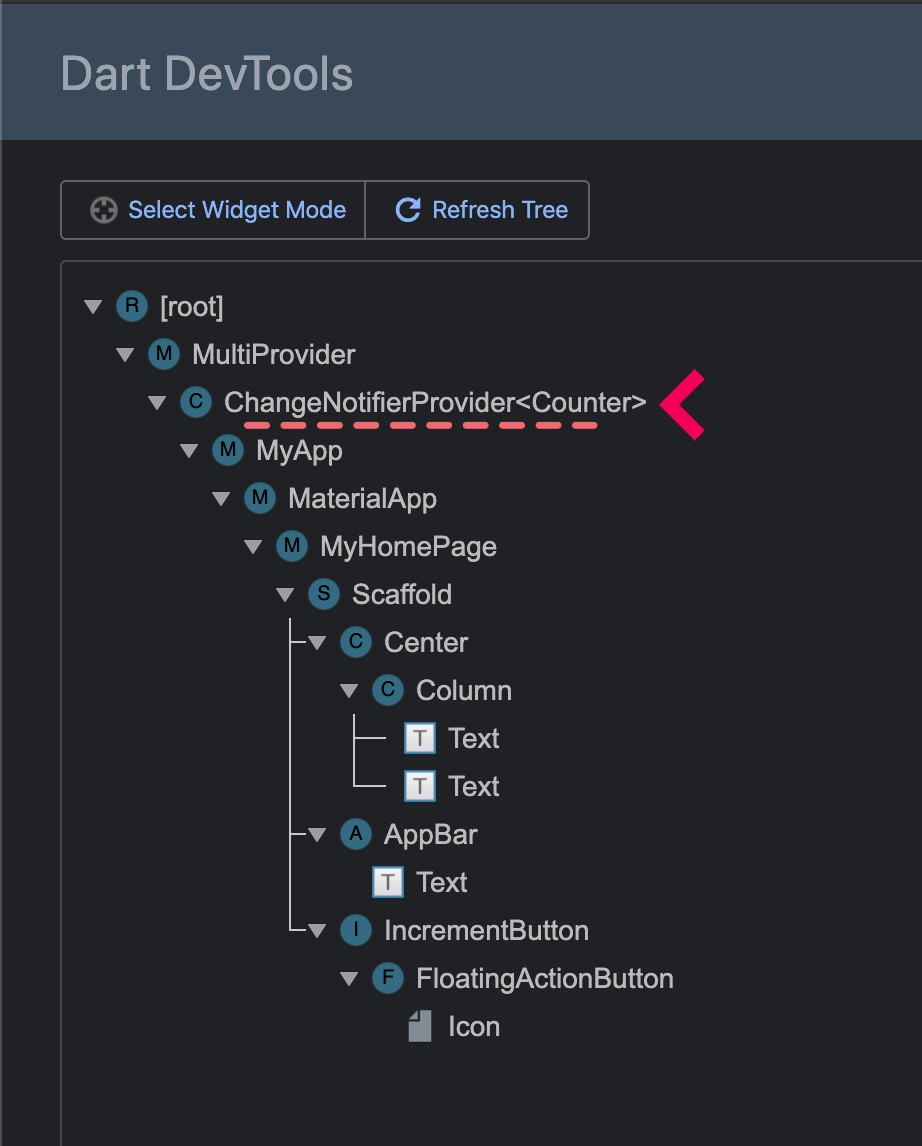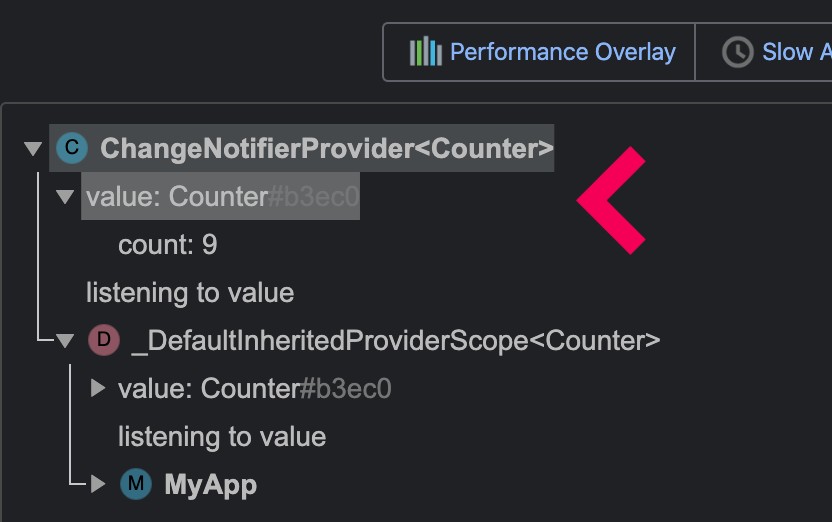Black Lives Matter. Support the Equal Justice Initiative.
A wrapper around InheritedWidget to make them easier to use and more reusable.
By using provider instead of manually writing InheritedWidget, you get:
- simplified allocation/disposal of resources
- lazy-loading
- a largely reduced boilerplate over making a new class every time
- devtools friendly
- a common way to consume these InheritedWidgets (See Provider.of/Consumer/Selector)
- increased scalability for classes with a listening mechanism that grows exponentially in complexity (such as ChangeNotifier, which is O(N²) for dispatching notifications).
To read more about provider, see its documentation.
See also:
- the official Flutter state management documentation, which showcase how to use
provider+ ChangeNotifier - flutter architecture sample, which contains an implementation of that app using
provider+ ChangeNotifier - flutter_bloc and Mobx, which use
providerin their architecture
-
The parameters
builderandinitialBuilderof providers are removed.initialBuildershould be replaced bycreate.builderof "proxy" providers should be replaced byupdatebuilderof classical providers should be replaced bycreate.
-
The new
create/updatecallbacks are lazy-loaded, which means they are called the first time the value is read instead of the first time the provider is created.If this is undesired, you can disable lazy-loading by passing
lazy: falseto the provider of your choice:FutureProvider( create: (_) async => doSomeHttpRequest(), lazy: false, child: ... )
-
ProviderNotFoundErroris renamed toProviderNotFoundException. -
The
SingleChildCloneableWidgetinterface is removed and replaced by a new kind of widgetSingleChildWidget.See this issue for details on how to migrate.
-
Selector now deeply compares the previous and new values if they are collections.
If this is undesired, you can revert to the old behavior by passing a
shouldRebuildparameter to Selector:Selector<Selected, Consumed>( shouldRebuild: (previous, next) => previous == next, builder: ..., )
-
DelegateWidgetand its family is removed. Instead, for custom providers, directly subclass InheritedProvider or an existing provider.
Providers allow to not only expose a value, but also create/listen/dispose it.
To expose a newly created object, use the default constructor of a provider.
Do not use the .value constructor if you want to create an object, or you
may otherwise have undesired side-effects.
See this stackoverflow answer
which explains in further details why using the .value constructor to
create values is undesired.
- DO create a new object inside
create.
Provider(
create: (_) => MyModel(),
child: ...
)- DON'T use
Provider.valueto create your object.
ChangeNotifierProvider.value(
value: MyModel(),
child: ...
)-
DON'T create your object from variables that can change over the time.
In such a situation, your object would never be updated when the value changes.
int count;
Provider(
create: (_) => MyModel(count),
child: ...
)If you want to pass variables that can change over time to your object,
consider using ProxyProvider:
int count;
ProxyProvider0(
update: (_, __) => MyModel(count),
child: ...
)NOTE:
When using the create/update callback of a provider, it is worth noting that this callback
is called lazily by default.
What this means is, until the value is requested at least once, the create/update
callbacks won't be called.
This behavior can be disabled if you want to pre-compute some logic, using the lazy parameter:
MyProvider(
create: (_) => Something(),
lazy: false,
)If you already have an object instance and want to expose it,
you should use the .value constructor of a provider.
Failing to do so may call the dispose method of your object when it is still in use.
- DO use
ChangeNotifierProvider.valueto provide an existing ChangeNotifier.
MyChangeNotifier variable;
ChangeNotifierProvider.value(
value: variable,
child: ...
)- DON'T reuse an existing ChangeNotifier using the default constructor
MyChangeNotifier variable;
ChangeNotifierProvider(
create: (_) => variable,
child: ...
)The easiest way to read a value is by using the extension methods on [BuildContext]:
context.watch<T>(), which makes the widget listen to changes onTcontext.read<T>(), which returnsTwithout listening to itcontext.select<T, R>(R cb(T value)), which allows a widget to listen to only a small part ofT.
Or to use the static method Provider.of<T>(context), which will behave similarly to watch/read.
These methods will look up in the widget tree starting from the widget associated
with the BuildContext passed, and will return the nearest variable of type
T found (or throw if nothing is found).
It's worth noting that this operation is O(1). It doesn't involve actually walking in the widget tree.
Combined with the first example of exposing a value, this
widget will read the exposed String and render "Hello World."
class Home extends StatelessWidget {
@override
Widget build(BuildContext context) {
return Text(
// Don't forget to pass the type of the object you want to obtain to `watch`!
context.watch<String>(),
);
}
}Alternatively, instead of using these methods, we can use Consumer and Selector.
These can be useful for performance optimizations or when it is difficult to
obtain a BuildContext descendant of the provider.
See the FAQ or the documentation of Consumer and Selector for more information.
When injecting many values in big applications, Provider can rapidly become
pretty nested:
Provider<Something>(
create: (_) => Something(),
child: Provider<SomethingElse>(
create: (_) => SomethingElse(),
child: Provider<AnotherThing>(
create: (_) => AnotherThing(),
child: someWidget,
),
),
),To:
MultiProvider(
providers: [
Provider<Something>(create: (_) => Something()),
Provider<SomethingElse>(create: (_) => SomethingElse()),
Provider<AnotherThing>(create: (_) => AnotherThing()),
],
child: someWidget,
)The behavior of both examples is strictly the same. MultiProvider only changes
the appearance of the code.
Since the 3.0.0, there is a new kind of provider: ProxyProvider.
ProxyProvider is a provider that combines multiple values from other providers
into a new object, and sends the result to Provider.
That new object will then be updated whenever one of the providers it depends on updates.
The following example uses ProxyProvider to build translations based on a
counter coming from another provider.
Widget build(BuildContext context) {
return MultiProvider(
providers: [
ChangeNotifierProvider(create: (_) => Counter()),
ProxyProvider<Counter, Translations>(
update: (_, counter, __) => Translations(counter.value),
),
],
child: Foo(),
);
}
class Translations {
const Translations(this._value);
final int _value;
String get title => 'You clicked $_value times';
}It comes under multiple variations, such as:
-
ProxyProvidervsProxyProvider2vsProxyProvider3, ...That digit after the class name is the number of other providers that
ProxyProviderdepends on. -
ProxyProvidervsChangeNotifierProxyProvidervsListenableProxyProvider, ...They all work similarly, but instead of sending the result into a
Provider, aChangeNotifierProxyProviderwill send its value to aChangeNotifierProvider.
Flutter comes with a devtool that shows what the widget tree is at a given moment.
Since providers are widgets, they are also visible in that devtool:
From there, if you click on one provider, you will be able to see the value it exposes:
(screenshot of the devtools using the example folder)
By default, the devtool relies on toString, which defaults to "Instance of MyClass".
To have something more useful, you have two solutions:
-
use the Diagnosticable API from Flutter.
For most cases, that will be done my using DiagnosticableTreeMixin on your objects, followed by a custom implementation of debugFillProperties.
class MyClass with DiagnosticableTreeMixin { MyClass({this.a, this.b}); final int a; final String b; @override void debugFillProperties(DiagnosticPropertiesBuilder properties) { super.debugFillProperties(properties); // list all the properties of your class here. // See the documentation of debugFillProperties for more information. properties.add(IntProperty('a', a)); properties.add(StringProperty('b', b)); } }
-
override
toString.If you cannot use DiagnosticableTreeMixin (like if your class is in a package that does not depend on Flutter), then you can simply override
toString.This is easier than using DiagnosticableTreeMixin but is less powerful: You will not be able to expand/collapse the details of your object.
class MyClass with DiagnosticableTreeMixin { MyClass({this.a, this.b}); final int a; final String b; @override String toString() { return '$runtimeType(a: $a, b: $b)'; } }
This exception happens because you're trying to listen to a provider from a life-cycle that will never ever be called again.
It means that you either should use another life-cycle
(didChangeDependencies/build), or explicitly specify that you do not care
about updates.
As such, instead of:
initState() {
super.initState();
print(context.watch<Foo>().value);
}you can do:
Value value;
didChangeDependencies() {
super.didChangeDependencies();
final value = context.watch<Foo>.value;
if (value != this.value) {
this.value = value;
print(value);
}
}which will print value whenever it changes.
Alternatively you can do:
initState() {
super.initState();
print(context.read<Foo>().value);
}Which will print value once and ignore updates.
I use ChangeNotifier and I have an exception when I update it, what happens?
This likely happens because you are modifying the ChangeNotifier from one of its descendants while the widget tree is building.
A typical situation where this happens is when starting an http request, where the future is stored inside the notifier:
initState() {
super.initState();
context.read<MyNotifier>().fetchSomething();
}This is not allowed, because the modification is immediate.
Which means that some widgets may build before the mutation, while other widgets will build after the mutation. This could cause inconsistencies in your UI and is therefore not allowed.
Instead, you should perform that mutation in a place that would affect the entire tree equally:
-
directly inside the
createof your provider/constructor of your model:class MyNotifier with ChangeNotifier { MyNotifier() { _fetchSomething(); } Future<void> _fetchSomething() async {} }
This is useful when there's no "external parameter".
-
asynchronously at the end of the frame:
initState() { super.initState(); Future.microtask(() => context.read<MyNotifier>(context).fetchSomething(someValue); ); }
It is slightly less ideal, but allows passing parameters to the mutation.
Do I have to use ChangeNotifier for complex states?
No.
You can use any object to represent your state. For example, an alternate
architecture is to use Provider.value() combined with a StatefulWidget.
Here's a counter example using such architecture:
class Example extends StatefulWidget {
const Example({Key key, this.child}) : super(key: key);
final Widget child;
@override
ExampleState createState() => ExampleState();
}
class ExampleState extends State<Example> {
int _count;
void increment() {
setState(() {
_count++;
});
}
@override
Widget build(BuildContext context) {
return Provider.value(
value: _count,
child: Provider.value(
value: this,
child: widget.child,
),
);
}
}where we can read the state by doing:
return Text(context.watch<int>().toString());and modify the state with:
return FloatingActionButton(
onPressed: () => context.read<ExampleState>().increment(),
child: Icon(Icons.plus_one),
);Alternatively, you can create your own provider.
Yes. provider exposes all the small components that make a fully-fledged provider.
This includes:
SingleChildCloneableWidget, to make any widget works withMultiProvider.- InheritedProvider, the generic
InheritedWidgetobtained when doingProvider.of. DelegateWidget/BuilderDelegate/ValueDelegateto help handle the logic of "MyProvider() that creates an object" vs "MyProvider.value() that can update over time".
Here's an example of a custom provider to use ValueNotifier as state:
https://gist.github.com/rrousselGit/4910f3125e41600df3c2577e26967c91
Instead of context.watch, you can use context.select to listen only to a
specific set of properties on the obtained object.
For example, while you can write:
Widget build(BuildContext context) {
final person = context.watch<Person>();
return Text(person.name);
}It may cause the widget to rebuild if something other than name changes.
Instead, you can use context.select to listen only to the name property:
Widget build(BuildContext context) {
final name = context.select((Person p) => p.name);
return Text(person.name);
}This way, the widget won't unnecessarily rebuild if something other than name
changes.
Similarly, you can use Consumer/Selector.
Their optional child argument allows to rebuild only a very specific part of
the widget tree:
Foo(
child: Consumer<A>(
builder: (_, a, child) {
return Bar(a: a, child: child);
},
child: Baz(),
),
)In this example, only Bar will rebuild when A updates. Foo and Baz won't
unnecessarily rebuild.
No. While you can have multiple providers sharing the same type, a widget will be able to obtain only one of them: the closest ancestor.
Instead, you must explicitly give both providers a different type.
Instead of:
Provider<String>(
create: (_) => 'England',
child: Provider<String>(
create: (_) => 'London',
child: ...,
),
),Prefer:
Provider<Country>(
create: (_) => Country('England'),
child: Provider<City>(
create: (_) => City('London'),
child: ...,
),
),Yes, a type hint must be given to the compiler to indicate the interface will be consumed, with the implementation provided in create.
abstract class ProviderInterface with ChangeNotifier {
...
}
class ProviderImplementation with ChangeNotifier implements ProviderInterface {
...
}
class Foo extends StatelessWidget {
@override
build(context) {
final provider = Provider.of<ProviderInterface>(context);
return ...
}
}
ChangeNotifierProvider<ProviderInterface>(
create: (_) => ProviderImplementation(),
child: Foo(),
),provider exposes a few different kinds of "provider" for different types of objects.
The complete list of all the objects available is here
| name | description |
|---|---|
| Provider | The most basic form of provider. It takes a value and exposes it, whatever the value is. |
| ListenableProvider | A specific provider for Listenable object. ListenableProvider will listen to the object and ask widgets which depend on it to rebuild whenever the listener is called. |
| ChangeNotifierProvider | A specification of ListenableProvider for ChangeNotifier. It will automatically call ChangeNotifier.dispose when needed. |
| ValueListenableProvider | Listen to a ValueListenable and only expose ValueListenable.value. |
| StreamProvider | Listen to a Stream and expose the latest value emitted. |
| FutureProvider | Takes a Future and updates dependents when the future completes. |



